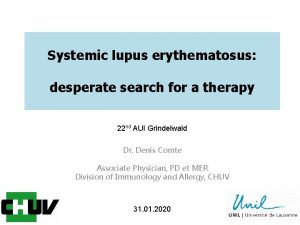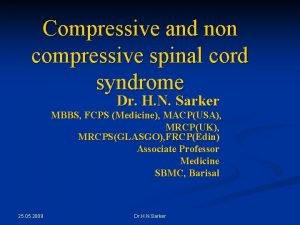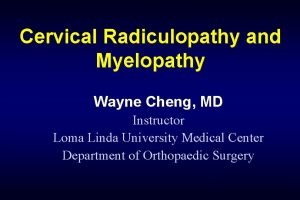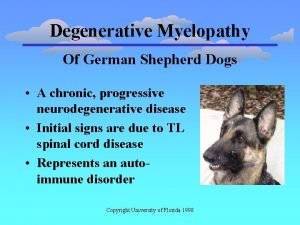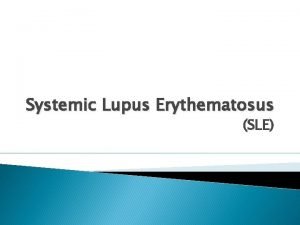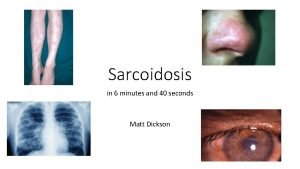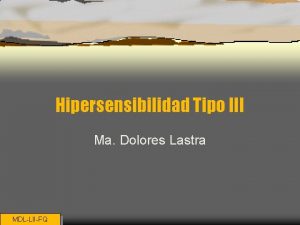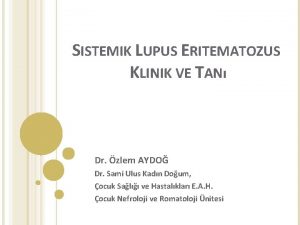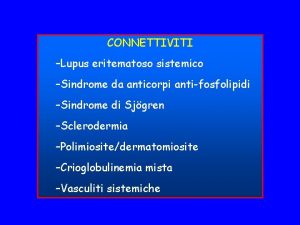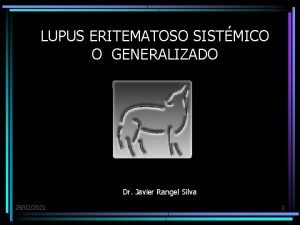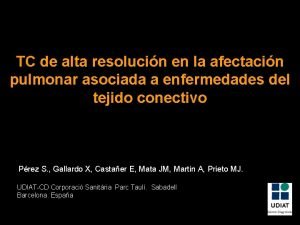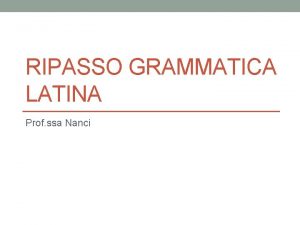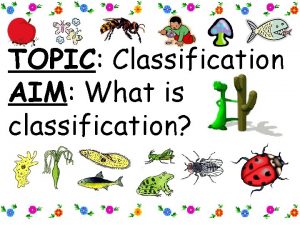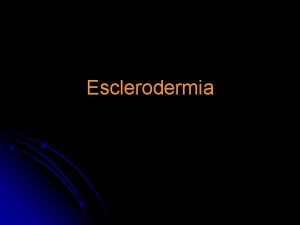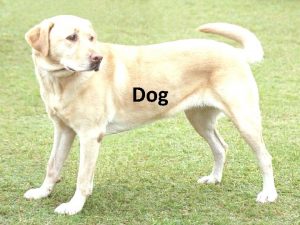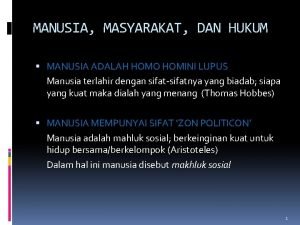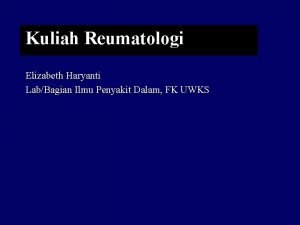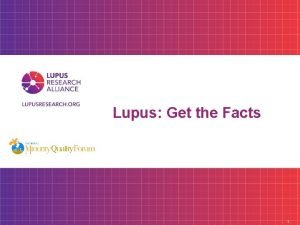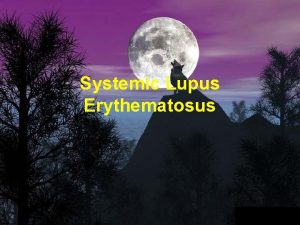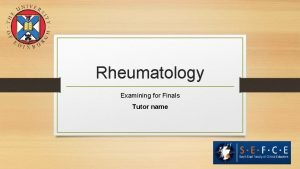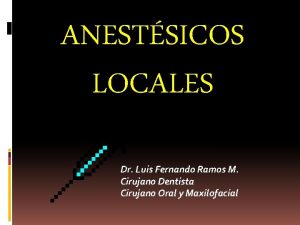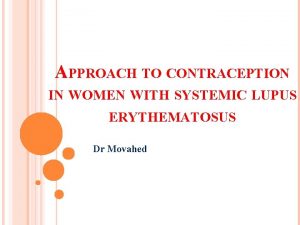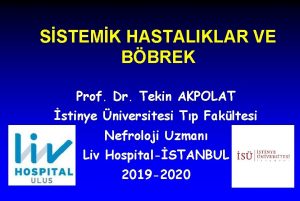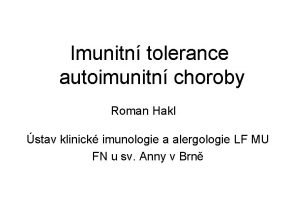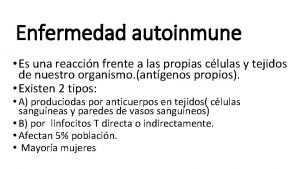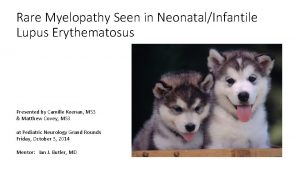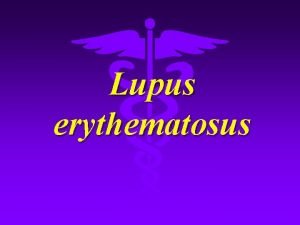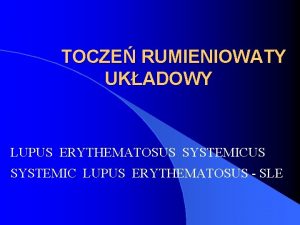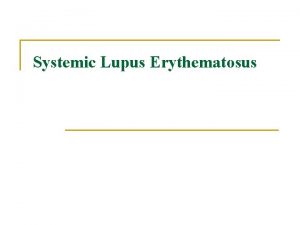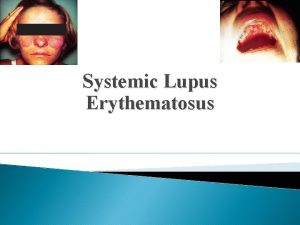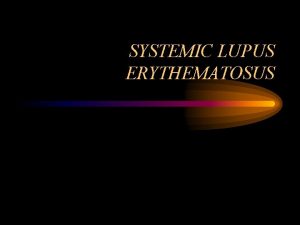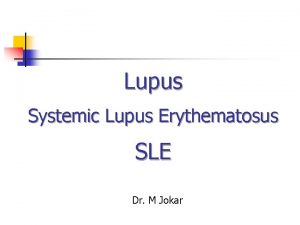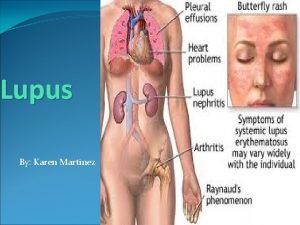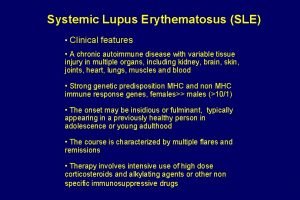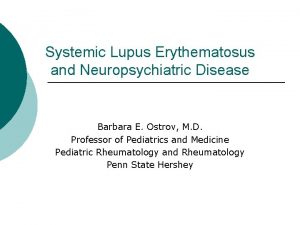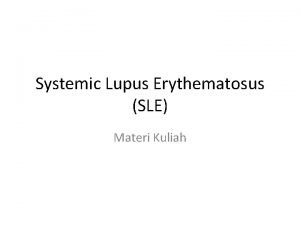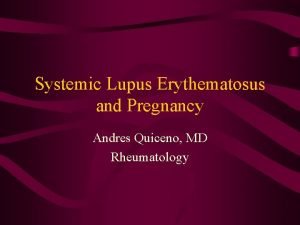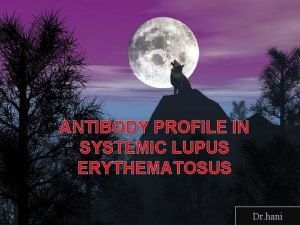Rare Myelopathy Seen in NeonatalInfantile Lupus Erythematosus Presented






































- Slides: 38

Rare Myelopathy Seen in Neonatal/Infantile Lupus Erythematosus Presented by Camille Keenan, MS 3 & Matthew Covey, MS 3 at Pediatric Neurology Grand Rounds Friday, October 3, 2014 Mentor: Ian J. Butler, MD

Chief complaint Child 1 • Full term African American female born with red and scaly butterfly rash. Child 2 • 3 month old African American male with scaly rash on cheeks.

History of present illness Child 1 Child 2 • No evidence of congential heart block • Rash faded to atrophy and hypopigmentation • Delays in standing and walking (evaluated at 16 months), otherwise normal development • Rash persisted and worsened • At 2 years – generalized seizure, scissoring gait with toe-walking, spasticity and weakness of legs • Rash and gait improved with IV and oral corticosteroids

Past medical history Child 1 • Full term, 3. 2 kg at birth • Family History • Mother with positive ANA (speckled), anti-Ro/SSA Ab, RF, and anti-SM Ab (but no clincal symptoms) • Later developed fever, polyarthritis, Coombs positive autoimmune hemolytic anemia, hypocomplementemia, and antibodies to native DNA and n. RNP Child 2 • Uneventful pregnancy, labor, and delivery • Family History • Mother had normal complement levels and negative ANA • Sister died of SLE, 2 other siblings clinically normal

Physical examination Child 1 Child 2 • Evaluated at 16 months due to delayed walking • LE spasticity • Increased reflexes, extensor plantar response • Contractures at the ankles • Flexed posture • Toe-walking, circumduction of right leg • UE normal • No sensory abnormalities • Reevaluated at age 3 due to neurological decline • LE spasticity • Increased reflexes, extensor plantar response • Flexion contractures of hips, knees, ankles • UE normal • Facial scarring

Physical examination Child 2 • Reevaluated at age 3 due to decline • LE spasticity • Flexion contractures of hips, knees, ankles • Increased reflexes, extensor plantar response • UE normal • Facial scarring Wu et al. Clinical presentations and molecular basis of complement C 1 r deficiency in a male African-American patient with systemic lupus erythematosus. Lupus 2011; 20: 10 -13.

Relevant labs Child 1 • Negative HSV serology and cultures • Anti-Ro/SSA detected (from 2 -8 months) • Negative anti-La/SSB Ab Child 2 • Negative ANA initially • 1: 80 ANA at age 2 with antiss. DNA, anti-ds. DNA, and anti-SM • Skin biopsy at 19 months – C 3 deposits at dermal-epidermal junctions • Elevated serum C 3 (227 mg/dl) and C 4 (116 mg/dl) at 19 months • Microscopic hematuria • Total C 1 r deficiency by age 3

Imaging/Diagnostics Child 1 • Normal brain CT, EEG, somatosensory evoked potentials, and myelogram • Normal CSF • Normal oligoclonal bands, myelin basic protein, Igs, and antineuronal Abs Child 2 • Normal brain CT, EEG, somatosensory and brainstem evoked potentials, and myelogram • Mild elevation of CSF myelin basic protein • Renal biopsy - mesangial glomerulonephritis with focal proliferative changes and C 3 and Ig. A deposits Image - Wu et al. Clinical presentations and molecular basis of complement C 1 r deficiency in a male African-American patient with systemic lupus erythematosus. Lupus 2011; 20: 10 -13.

Differential diagnosis – based on initial skin manifestations • TORCH infections – newborn rash • Toxoplasmosis, Rubella, CMV, HSV • • Telangiectasia Hemangioma Dermatophytosis Eczema Stevens Johnson Syndrome MRSA Epidermolysis bullosa Neonatal lupus erythematosus Johnson, Benay. Overview of Neonatal Lupus. Journal of Pediatric Health Care 2014; 28(4): 331 -341.


Famous Lupus Patients Flannery O’Connor, author of A Good Man is Hard to Find Ludwig von Beethoven

Historical Perspective • Hippocrates: “herpes esthiomenos” – “gnawing dermatosis” • Lupus sufferers in the Middle Ages were feared to be able to transform into animals (werewolves) • Virchow: any necrosis or ulceration of the face was called lupus before the mid-1800 s

Historical Perspective Cont. • Osler: coined the term “systemic lupus erythematosus” at the turn of the 19 th century • Modern understanding began in 1948 with the mixing of SLE serum with normal subjects • Classification criteria (4 out of 14) established in 1971 by the American College of Rheumatology

Systemic Lupus International Collaborating Clinics (SLICC) clinical/immunological criteria (2012) Cutaneous (4) Joints (1) Serositis (1) Renal (1) Hematologic (3) Immunologic (6) Dx ACLE/SCLE (typically malar & photosensitive rash) Synovitis in 2+ peripheral joints Pleuritis or EKG evidence of pericardial fusion urine protein > 0. 5 g/24 h Hemolytic anemia + ANA 4+ Items (with 1+ clinical, 1+ immune) RBC casts Leukopenia or lymphopenia + anti-ds. DNA Thrombocytopenia Anti-Sm CCLE (aka discoid LE) Oral ulcers Non-scarring alopecia Antiphospholipid antibody Low complement (C 3, C 4, CH 50) Direct Coombs (in absence of hemolytic anemia)

ACR neuropsychiatric syndromes seen in SLE CENTRAL NERVOUS SYSTEM PERIPHERAL NERVOUS SYSTEM Aseptic meningitis Acute inflammatory demyelinating polyradiculoneuropathy Cerebrovascular disease Guillain-Barre syndrome Demyelinating syndrome Autonomic disorder Headache (includes migraine and benign intracranial hypertension) Mononeuropathy, single/multiplex Movement disorder (chorea) Myasthenia gravis Myelopathy Cranial neuropathy Seizure disorder Plexopathy Acute confusional state; cognitive dysfunction Polyneuropathy Anxiety & mood disorders, psychosis ***Validated in 2001 in a population-based study covering 440, 000 people Jeltsch-David H, and Muller, S, 2014

Neuropsychiatric SLE • Up to 75% of adults and kids with SLE will experience some type of neuropsychiatric effects of the disease

Etiology/Pathophysiology/Genetics Neonatal Lupus Erythematosus (NLE) • Between 1/12, 500 -20, 000 newborns have NLE • Maternal autoantibodies (Ig. G) cross placenta • Mother may appear healthy or have known AI disease • Anti-Ro/SSA and Anti-La/SSB are heavily implicated • Antibodies deposit in various areas (i. e. the calcium channels in the myocardium) and initiate an inflammatory response • Neural and cardiac tissues have the largest amount of Ro/SSA antigen

Clinical Presentation Neonatal Lupus Erythematosus (NLE) • Can present in utero • Presumptive with any degree of heart block (usually begins 2 nd trimester) • Can present postnatally • Often diagnosed based on skin manifestations (can be different from mother’s)

15 -25% of neonates with NLE present with typical skin findings Annular erythema in 4 -week old girl “owl eyes” or raccoon eyes” in a 12 week-old girl “Erythema multiforme-like” plaques in 12 -week old boy “seborrheic” plaques in 23 week old boy Inzinger, Martin, et al. “Neonatal lupus erythematosus and its clinical variability. ” Journal der Deutschen Dermatologischen Gesellschaft. 2012: 407 -410.

Natural Progression of Disease Neonatal Lupus Erythematosus (NLE) • Normal pregnancies with most women with high Anti-Ro/SSA titers • Cutaneous, hepatobiliary, or hematologic NLE findings usually reverse by 6 months – coincides with the lifespan of maternal Ig. G • Atrophy and pigmentation changes can remain in skin findings • 3 rd degree heart block permanent; myelopathy rare complication • NLE pts at higher risk for developing an AI disease later

Etiology/Pathophysiology/Genetics INFANTILE Lupus Erythematosus (ILE) • Homozygous mutation in C 1 r gene: C T mutation at nucleotide-6392 in exon 10 of the C 1 R gene – stop codon (R 380 X) • Homozygous deficiencies of early components for complement activation are major risk factors for SLE • The mother of the infant in case 2 was heterozygous for the mutation; father not available for testing • The R 380 X mutation is a rare variant but plays a big role in SLE development • C 1 r deficiency has been strongly correlated with SLE for 40 years, but only in 2011 has the molecular basis been discovered Wu YL, et al. Clinical presentations and molecular basis of complement C 1 r deficiency in a male African-American patient with systemic lupus erythematosus. Lupus 2011; 20: 10 -13.

http: //mcr. aacrjournals. org/content/8/11/1453/F 1. expansion. html

Etiology/Pathophysiology/Genetics Cont. INFANTILE Lupus Erythematosus (ILE) • C 1 r & C 1 s form a tetramer that must remain stable • Leads to reduced activation and consumption of C 4 and C 2 • lowers the engagement of the C 1 -inhibitor • higher levels of C 4 & C 2 in the circulation

Etiology/Pathophysiology/Genetics Cont. INFANTILE Lupus Erythematosus (ILE) • Overall, the patient is complement-deficient, especially in the Classical pathway • Poor long-term clearance of apoptotic/necrotic material • Loss of immunotolerance • Autoimmunity develops Wu YL, et al. Clinical presentations and molecular basis of complement C 1 r deficiency in a male African-American patient with systemic lupus erythematosus. Lupus 2011; 20: 10 -13.

Clinical Presentation Infantile Lupus Erythematosus (ILE) • Complement-deficient patients are more susceptible to bacterial infection • Severe cutaneous lesions • High renal disease prevalence • Earlier onset of SLE than non-complement-deficiency

Natural Progression of Disease Infantile Lupus Erythematosus (ILE) • End-organ damage & eventually death • Complications from steroid treatment (i. e. infection)

Diagnostics • No specific diagnostic criteria • Presence of anti-Ro/SSA, anti-La/SSB, anti-RNP Abs in any combination warrants further evaluation • Prenatal • Test fetal anti-Ro/SSA and anti-La/SSB Abs if mother is at risk (lupus, Sjogren, other autoimmune disorder, previous NL pregnancy) • Mother with SLE and previous neonatal lupus pregnancy – serial fetal ECG starting at 16 weeks • Monitor for signs of congenital heart block (CHB) beginning in second trimester (persistent bradycardia)

Diagnostics cont. • Postnatal • Skin manifestations – skin biopsy showing characteristic vacuolation, lymphocytic infiltration, and Ig. M deposits • Serum antibody levels • Congenital heart block – for persistent bradycardia, evaluate with ECG and Doppler • ECG for all infants born to mothers with anti-Ro/SSA and/or anti-La/SSB Abs

Diagnostics – brain MRI for rare CNS findings Altered signal intensity in right cerebral hemisphere and left occipital lobe consistent with subacute infarct and subacute subdural hemorrhage. Diffusely attenuated right supraclinoid internal carotid artery, ACA, MCA (A, arrow) and PCA (B, arrow); bilaterally decreased cortical vasculature and right-sided cerebral chronic infarct. Saini et al. CNS vasculitis and stroke in neonatal lupus erythematosus: A case report and review of literature. European Journal of Pediatric Neurology 2014; 18(3): 444 -448.

Diagnostics – brain MRI for rare CNS findings 3 month follow-up: Right cerebral hemi-atrophy with cystic encephalomalacic changes and marked volume loss; markedly attenuated MCA. Clinically – incomplete head control, intermittent visual fixation and leftsided hemiparesis with cortical thumb Saini et al. CNS vasculitis and stroke in neonatal lupus erythematosus: A case report and review of literature. European Journal of Pediatric Neurology 2014; 18(3): 444 -448.

Management/Treatment – In utero • Management • Hydroxychloroquine • May decrease risk of cardiac manifestations of neonatal lupus • The only suggested preemptive therapy (for mother with previous NL pregnancy) • Treatment • Prenatal prednisone or dexamethasone • Produces good outcomes in neonates, can reverse 1 st or 2 nd degree heart block but not 3 rd or complete • IVIG – to decrease ability of antibodies to cross placenta • Steroid + IVIG = better results than steroid alone, although congenital heart block can still occur Johnson, Benay. Overview of Neonatal Lupus. Journal of Pediatric Health Care 2014; 28(4): 331 -341.

Management/Treatment – Newborn • Management • Ongoing heart block requires pacemaker • Follow-up screening if patient has a positive maternal history (even if prenatal screening was negative) • Instruct to avoid direct sunlight • Treatment • • • No treatment for 3 rd degree or complete heart block Prednisolone IVIG Or both steroid and IVIG depending on symptom severity For skin manifestations • Topical steroids • Laser therapy for persisting lesions Johnson, Benay. Overview of Neonatal Lupus. Journal of Pediatric Health Care 2014; 28(4): 331 -341.

Prognosis • Typically newborn symptoms subside after 6 months (life of the Ig. G Ab), except 3 rd degree heart block • Poorer outcomes if premature, low birth weight, low ventricular rate or dysfunction, or have structural heart disease • Cardiac • Exercise limitation and possible death in patients with asymptomatic complete heart block (hence without pacemaker) • Fatality later in life due to possible pacemaker failure • 5 -11% risk of cardiomyopathy even with pacemaker • Skin • Benign, but help identify risk factors for more serious disorders in family

Ongoing research/Recent development • Future treatment goal • Decrease levels of autoantibodies • Continue to use whole-genome and exome sequencing • Find all the causal variants of SLE

Summary • Consider neonatal lupus in differential for newborns/infants presenting with seizures, even when lacking cardiac or cutaneous findings • Negative maternal history (no SLE and/or associated Abs) does not rule out infantile lupus – consider complement deficiency • Further research needed to ID biomarkers useful in predicting outcomes and treating SLE

Summary cont. Nature vs. • Inherited genetic defect affecting normal immune response development of Abs • Infantile presentation Nurture • Transplacental transfer of autoantibodies from mother to fetus • Neonatal presentation Auto-antibody mediated damage to native tissues Patient with lupus erythematosus including cutaneous manifestations and myelopathy.

References • Kaye EM, Butler IJ, Conley S. Myelopathy in neonatal and infantile lupus erythematosus. Journal of Neurology, Neurosurgery, and Psychiatry. 1987; 50: 923 -926. • Wu YL, Brookshire BP, Verani RR, Arnett FC, Yu CY. Clinical presentations and molecular basis of complement C 1 r deficiency in a male African-American patient with systemic lupus erythematosus. Lupus. 2011; 20: 10 -13. • Inzinger, Martin, et al. “Neonatal lupus erythematosus and its clinical variability. ” Journal der Deutschen Dermatologischen Gesellschaft. 2012: 407 -410. • Johnson, Benay. Overview of Neonatal Lupus. Journal of Pediatric Health Care. 2014; 28(4): 331 -341. • Jeltsch-David H, and Muller, S. “Neuropsychiatric systemic lupus erythematosus: pathogenesis and biomarkers. Nat Rev Neurol. 2014: Epub ahead of print. • Mallavarapu, Ravi and Grimsley, Edwin. “The history of lupus erythematosus. ” Southern Medical Journal. 2007: 896 -8. • Saini AG, Naveen S, Bhattad S, Vyas S, Saikia B, Singhi P. CNS vasculitis and stroke in neonatal lupus erythematosus: A case report and review of literature. European Journal of Paediatric Neurology. 2014; 18(3): 444 -448. • Buyon, JP. Neonatal lupus. In: Up. To. Date, Post TW (Ed), Up. To. Date, Waltham, MA. (Accessed on September 30, 2014. ) • Yu, Cong, et al. “Diagnostic criteria for systemic lupus erythematosus: A critical review. ” Journal of Autoimmunity. 2014: 10 -13.

Special Thanks to… • Dr. Butler • Dr. Bala, Dr. Fitzgerald, and Dr. Grant Any Questions?
 Case study 87 systemic lupus erythematosus
Case study 87 systemic lupus erythematosus Front immunology
Front immunology Cervical myelopathy wayne
Cervical myelopathy wayne Non compressive myelopathy
Non compressive myelopathy Wayne cheng md
Wayne cheng md Surfer's myelopathy
Surfer's myelopathy Degenerative myelopathy wayne
Degenerative myelopathy wayne Matchstick sign lupus vulgaris
Matchstick sign lupus vulgaris Lupus simptoms
Lupus simptoms Uveiitis
Uveiitis Lupus eritematoso sistémico
Lupus eritematoso sistémico Lupus eritematoso sistémico
Lupus eritematoso sistémico Immune
Immune Asuhan keperawatan sle pada anak
Asuhan keperawatan sle pada anak Slicc kriterleri
Slicc kriterleri Facies sclerodermica
Facies sclerodermica Complemento lupus
Complemento lupus Vidrio deslustrado
Vidrio deslustrado Michelle petri md
Michelle petri md Grammatica latina ripasso
Grammatica latina ripasso Genus and species examples
Genus and species examples Raynaud
Raynaud Canis lupus familiaris classification
Canis lupus familiaris classification Malattia lupus è mortale
Malattia lupus è mortale Nvle fonds
Nvle fonds Doktrin
Doktrin Reumatologi
Reumatologi Lupus research alliance
Lupus research alliance La rana e il bue
La rana e il bue Anti sm antibody
Anti sm antibody Jaccoud's arthropathy lupus
Jaccoud's arthropathy lupus Lupus
Lupus Lupus presentation powerpoint
Lupus presentation powerpoint Padrao full house lupus
Padrao full house lupus Iud and lupus
Iud and lupus Nekrotizan papillit nedir
Nekrotizan papillit nedir Lupus
Lupus Lupus eritematoso sistémico
Lupus eritematoso sistémico Declinazione lupus
Declinazione lupus

